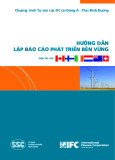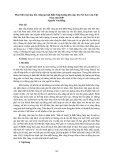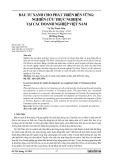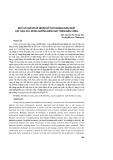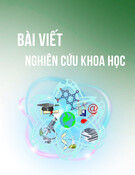
JSTPM Vol 13, No 3+4, 2024 41
NEW TRENDS IN SCIENCE, TECHNOLOGY AND INNOVATION
POLICY DEVELOPMENT TO PROMOTE GREEN GROWTH AND
SUSTAINABLE DEVELOPMENT
Dang Thu Giang
1
National Institute for Science and Technology Policy and Strategy Studies
Cao The Anh
Viettel Group
Duong Kieu Trinh
Viet Nam Union of Friendship Organizations
Summary:
Science, technology and innovation (STI) are key elements in ensuring and promoting green
growth and sustainable development. Despite this, the world continues to face persistent
challenges in energy, climate change, and environmental risks to people's health and well-
being, while rapid technological advancements introduce new risks and uncertainties.
Therefore, the problem for STI policymakers is to promote economic growth while
minimizing the unwanted impacts of STIs on the environment and social security, with the
core motto “leaving no one behind”. This article aims to understand the trends of the STI
policy development in the world in the context of green growth, and sustainable development
thereby linking it to Vietnam and identifying the problems posed to it. The article comprises
four sections: (1) Trends in green growth, and sustainable development and the role of STI;
(2) Green growth and sustainable development requirements for the STI policy development;
(3) New trends in the STI policy development in the context of green growth and sustainable
development; (4) Implications for STI policy development in Vietnam.
Keywords: Science and technology; Innovation; Policy; Green growth; Sustainable
development.
Code: 24091601
1. Green growth, and sustainable development trends and the role of
science, technology and innovation
1.1. Green growth, and sustainable development trends in the world and in
Vietnam
The terms “green growth” and “sustainable development” first appeared in
1980 in the World Conservation Strategy (published by the International
Union for Conservation of Nature and Natural Resources - IUCN) and were
1
Author’s contact: giangdangthu@yahoo.com

42 New trends in science, technology and innovation policy development...
widely popularized in 1987 in the Brundtland Report (also known as Our
Common Future Report) of the World Commission on Environment and
Development - WCED (now the Brundtland Commission).
This report defines green growth as “development that can meet the needs of
the present without affecting or harming the ability to meet the needs of
future generations...”. In other words, green growth must ensure effective
economic development, social equity, and environmental protection and
preservation. Green growth is an important orientation for sustainable
development, contributing directly to reducing greenhouse gas emissions
towards a carbon-neutral economy in the long term.
Green growth is characterized by: (i) development is based on the efficient
use of resources through the application of advanced technologies, clean
production processes, and energy saving; (ii) minimizing greenhouse gas
emissions, and environmental pollution and protecting biodiversity; (iii)
ensuring the social equity, improving people's living standards, creating job
opportunities for everyone and innovation in the fields of science and
technology, especially in the fields of renewable energy, green technology,
and environmental protection.
Also in this Report, “sustainable development” is mentioned with the
content: “human development cannot only focus on the economic
development but must also respect the essential needs of society and the
impact on the ecological environment”. This report has put forward the goal
of sustainable development as “achieving sustainable development by
conserving biological resources”. The term “sustainable development” here
is referred to in a narrow sense, emphasizing the ecological sustainability of
development, and calling for the conservation of biological resources.
The term gained widespread recognition in 1987 through the Brundtland
Report (also known as the Our Common Future Report) of the World
Commission on Environment and Development - WCED (now the
Brundtland Commission). This report clearly stated that sustainable
development is “the development that can meet the needs of the present
without affecting or compromising the ability of future generations to meet
their own needs...”. This term mainly emphasizes the effective use of natural
resources and ensuring the living environment for people in the development
process. Sustainable development is a model of optimal transformation of
economic and social benefits in the present without harming the potential of
similar benefits in the future (Godian and Hecdue, 1988, Prof. Grima Lino).
The connotation of sustainable development was reaffirmed at the Earth
Summit on Environment and Development held in Rio de Janeiro (Brazil) in
1992 and supplemented and completed at the World Summit on Sustainable

JSTPM Vol 13, No 3+4, 2024 43
Development held in Johannesburg (South Africa) in 2002: “Sustainable
development” is a development process that closely, reasonably and
harmoniously combines three aspects of development, including economic
development (especially economic growth), social development (especially
making progress, social justice; hunger eradication, poverty reduction, and
job creation) and environmental protection (especially pollution treatment,
remediation, environmental quality improvement; forest fire prevention and
deforestation; rational exploitation and economical use of natural resources).
Sustainable development is the development that satisfies the needs of the
present generation without harming the ability to meet the needs of future
generations.
According to the Asian Development Bank (ADB): “Sustainable
development is a new type of development that integrates production
processes with resource conservation and environmental quality
improvement. Sustainable development must meet the needs of the present
generation without harming our ability to meet the needs of future
generations.”
Green growth and sustainable development have become a common trend
and development strategy of the whole world, especially in the context of
very strong integration and globalization process as well as climate change,
which has become the biggest challenge for humanity in the 21st century. In
September 2015, the United Nations adopted the 2030 Agenda for
Sustainable Development. The core of the 2030 Agenda is 17 sustainable
development goals (SDGs), in which science, technology and innovation are
key tools for implement the SDGs, alongside financial investment and
institutional environment.
Along with many countries in the region and in the world, green growth and
sustainable development are identified as one of the focuses in Vietnam's
development policy, affirmed in important guiding documents of the Party
and State. The Resolution of the 13th National Party Congress has identified
the guiding viewpoint of “rapid and sustainable development of the country”,
building a green economy, a circular economy, and an environmentally
friendly economy as an important orientation for national development
during the 2021 - 2030 period.
In order to implement the above-mentioned orientation, Resolution No. 29-
NQ/TW dated November 17, 2022, of the 13th Party Central Committee on
continuing to promote industrialization and modernization of the country to
2030, with a vision to 2045; Resolution No. 50/NQ-CP dated May 20, 2021
of the Government on the Government's action program to implement the
Resolution of the 13th National Party Congress were issued, creating a

44 New trends in science, technology and innovation policy development...
foundation for organization and implementation, in which green growth is
considered as a breakthrough with long-term strategic significance.
The Government, ministries, sectors, and localities have issued many legal
documents, programs, action plans, and directives on green and sustainable
growth such as National Green Growth Strategy for the period 2021 - 2030,
and Vision to 2050; National Action Plan on Green Growth for the period
2021 - 2030; National Action Plan to implement the 2030 Agenda for
Sustainable Development; National Strategy on Climate Change for the
period up to 2050; Strategy for Science, Technology and Innovation
Development to 2030; Strategy for Sustainable Agricultural and Rural
Development for the period 2021 - 2030, and vision to 2050; Circular
Economy Development Project in Vietnam;…
On the journey to achieve sustainable development goals, Vietnam continues
to commit and act on transformation, development of a green economy,
circular economy, and clean energy to achieve the net zero emissions goal by
2050. The National Strategy on Green Growth for the period 2021 - 2030,
and vision 2050, affirms that Vietnam's green growth and sustainable
development are based on the 3 main pillars foundation of: (i) Transforming
the growth model towards greening economic sectors; (ii) Building a green
lifestyle combined with beautiful traditional lifestyles to create a high-quality
life in harmony with nature; creating a sustainable consumption culture; (iii)
Improving the quality of life and the resilience of people to climate change,
ensuring equality in conditions, and opportunities to develop the capacity and
to enjoy the fruits of development, leaving no one behind in the green
transformation process.
1.2. The role of science, technology and innovation in green growth and
sustainable development
Science, technology and innovation are some of the main factors that play a
positive or negative role in sustainable development, along with other factors
such as governance (executive, legislative, judicial), management, education,
and civil society (Kongoli, 2016). While advances in science, technology and
innovation solve many practical problems, they also create challenges for
society (Parens et al., 2009). The emergence of information technology has
created great advances in health, education, transportation, and human-to-
human communication. However, it has also introduced security risks and
privacy violations. Rapid advances in biotechnology, nanotechnology, and
neuroscience have the potential to be applied to other areas of science to
improve the quality of human life, but the technologies and chemicals created
from these areas will bring about unpredictable changes in human biology.
Technological change will often entail a demand for capital and highly

JSTPM Vol 13, No 3+4, 2024 45
qualified and skilled labor. As a result, unskilled labor may be displaced,
leading to a reduction in employment. Therefore, the adoption of new
technologies will also mean changes in the labor structure of society, which
may lead to increased inequality. In particular, in the short term, developing
countries may face a difficult adjustment process as their economies are
hardly adapted to new production structures. The direct impact of innovation
in the short term is to improve labor productivity, which can help to produce
the same output with less labor force and therefore can have an adverse
impact on workers' employment.
In Vietnam, science, technology and innovation are increasingly asserting
their role as a strong driving force for the country's rapid and sustainable
development, playing a strategic breakthrough role in shifting the economic
model from “brown” to “green”, and providing the solutions to address social
and environmental challenges such as hunger eradication, poverty reduction,
improving food security, nutrition and agricultural development, and
promoting access to and efficiency of energy, disease prevention and health
improvement, etc.
2. Requirements from green growth and sustainable development to
science, technology and innovation policy development
2.1. Challenges for green growth, and sustainable development
Green growth and sustainable development are inevitable trends. However,
they require significant investments to transform the system from “brown”
to “green”. According to the World Bank (WB), to realize the goal of
achieving net zero emissions by 2050 to implement Vietnam's commitment
at the 26th Conference of the Parties to the United Nations Framework
Convention on Climate Change (COP26), Vietnam will need up to 380
billion USD to invest in. In context, Vietnam faces numerous challenges,
including the instability of the global economy which is still having certain
impacts on the macro economy, and making the economic recovery process
potentially risky, forcing policymakers and localities to not only have to
consider long-term sustainable development but also have to overcome the
immediate difficulties and shortcomings that businesses, people and
localities are facing at.
In addition, there are challenges in infrastructure, energy, policy, and
awareness, specifically:
-
Infrastructure constraints: Lack of infrastructure needed to support green
growth, which can hinder the widespread adoption of green technologies
and sustainable production methods;





